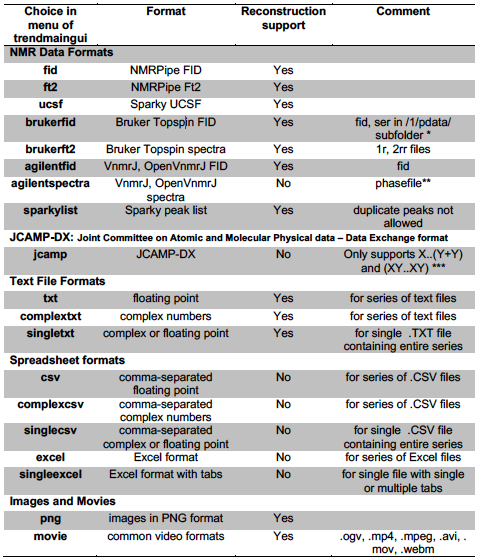Table File formats read and reconstructed by TREND$

$ See TREND manual for details.
* Currently the processed spectra must be saved by setting processing number as 1.
** In order to make phasefile readable by third-party software including TREND, set trace=’f1’,
display the full spectrum, and use the VnmrJ flush command are required. Otherwise the phasefile
will be all zero values. See
Sparky manual
*** JCAMP-DX is a general format for exchanging and archiving data from many instruments,
including but not limited to IR, Raman, Uv-Vis, Fluorescence, NMR, and EMR. The data stored in
JCAMP-DX files can be spectral plots, contours, or peak tables. TREND supports the most common
JCAMP-DX formats. The digital data in JCAMP-DX can be AFFN (ASCII FREE FORMAT NUMERIC) form or
ASDF (ASCII SQUEEZED DIFFERENCE FORM). TREND supports decoding compressed data, including PAC,
SQZ, DIF, SQZDUP, and DIFDUP. Two most common tabular data forms, (X++(Y..Y)) and (XY..XY) are
supported. TREND reads a series of JCAMP-DX files, or a single JCAMP-DX file with one or multiple
blocks. TREND supports NTUPLE format (introduced by JCAMP-DX 5.0 standard), which is designed for
multi-dimensional techniques with data sets of multiple variable. For example, JCAMP-DX NMR uses
NUTPLE to show mixed real/imaginary FID data sets. See http://www.jcamp-dx.org/ ,
https://badc.nerc.ac.uk/help/formats/jcamp_dx/ and http://wwwchem.uwimona.edu.jm:1104/spectra/testdata/index.html for format details